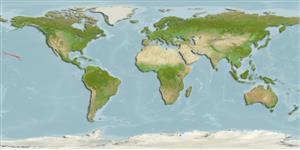Environment: milieu / climate zone / depth range / distribution range
Écologie
marin récifal; profondeur 20 - 174 m (Ref. 58302). Tropical; 30°N - 17°N
Eastern Central Pacific: endemic to the Hawaiian Islands. Have recently been reported from Midway Islands (Ref. 28620).
Taille / Poids / Âge
Maturity: Lm ? range ? - ? cm
Max length : 21.0 cm TL mâle / non sexé; (Ref. 4858)
Description synthétique
Clés d'identification | Morphologie | Morphométrie
Sexes exhibit different coloration. Male pearly white with anterior portion of the head, from the snout to just behind the eye, yellow orange; anterior half of the caudal fin black; dorsal and anal fins white with a broad orange band distally; the pectoral and pelvic fins orange. Female pearly white with anterior portion of the head, from the snout to just behind the eye black or gray; anterior half of the caudal fin also black; distal portion of pelvic fins orange.
Inhabits seaward reefs (Ref. 9710). Benthopelagic over rock and sand (Ref. 58302). Minimum depth from Ref. 122680.
Life cycle and mating behavior
Maturities | Reproduction | Spawnings | Egg(s) | Fecundities | Larves
Allen, G.R., 1985. Butterfly and angelfishes of the world. Vol. 2. 3rd edit. in English. Mergus Publishers, Melle, Germany. (Ref. 4858)
Statut dans la liste rouge de l'IUCN (Ref. 130435)
Menace pour l'homme
Harmless
Utilisations par l'homme
Pêcheries: sans intérêt; Aquarium: Commercial
Outils
Articles particuliers
Télécharger en XML
Sources Internet
Estimates based on models
Preferred temperature (Ref.
123201): 9.1 - 20.6, mean 14.1 °C (based on 19 cells).
Phylogenetic diversity index (Ref.
82804): PD
50 = 0.5010 [Uniqueness, from 0.5 = low to 2.0 = high].
Bayesian length-weight: a=0.03090 (0.01359 - 0.07026), b=2.89 (2.70 - 3.08), in cm total length, based on LWR estimates for this (Sub)family-body shape (Ref.
93245).
Niveau trophique (Ref.
69278): 2.7 ±0.31 se; based on food items.
Résilience (Ref.
120179): Milieu, temps minimum de doublement de population : 1,4 à 4,4 années (Preliminary K or Fecundity.).
Fishing Vulnerability (Ref.
59153): Low vulnerability (11 of 100).
Nutrients (Ref.
124155): Calcium = 60 [30, 94] mg/100g; Iron = 0.585 [0.356, 0.974] mg/100g; Protein = 18.1 [16.9, 19.3] %; Omega3 = 0.119 [0.074, 0.191] g/100g; Selenium = 37.8 [20.6, 69.9] μg/100g; VitaminA = 74.9 [19.1, 275.0] μg/100g; Zinc = 1.41 [0.97, 2.02] mg/100g (wet weight);
